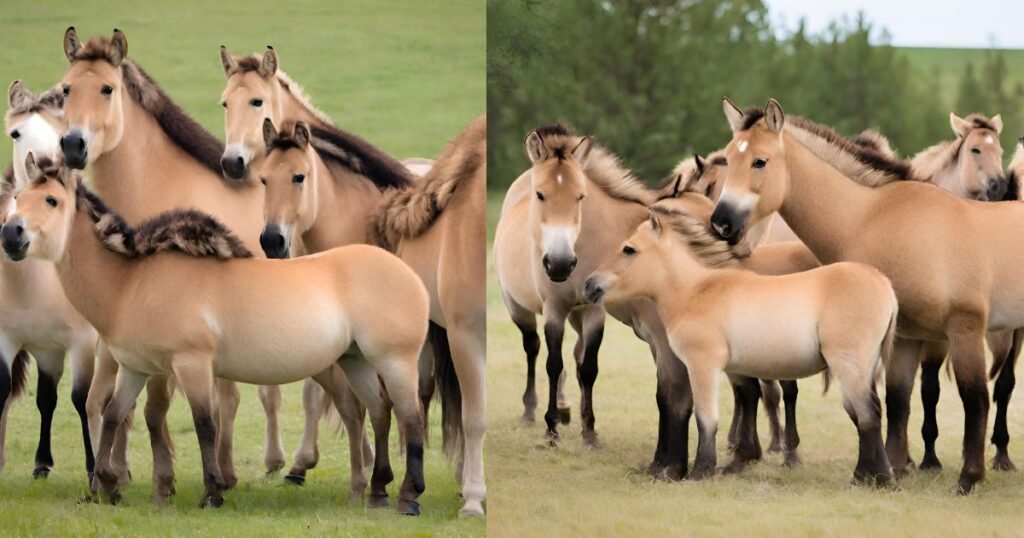Introduction:
The Przewalskis horse is a rare and endangered horse that is native to the steppes of Central Asia. It bears Nikolay Przhevalsky’s name, a Russian explorer and geographer. Since the 1990s, Mongolia’s Khustain Nuruu National Park, Takhin Tal Nature Reserve, and other locations have been used to return this once-extinct species to its natural environment, and Khomiin Tal, as well as several other locales in Central Asia and Eastern Europe.
In this blog post, we will explore the unique characteristics of the Przewalski’s horse, including its height, population, and hybridization with domestic horses.
What is unique about the Przewalskis Horse?

Compared to its domesticated ancestors, the Przewalski’s horse is shorter, smaller, and has a stockier build. The usual height and weight are around 12–14 hands (48–56 inches, 122–142 cm) and 300 kg (660 lb), respectively. They frequently have dark primitive patterns and a dun coat with pangaré traits.
Compared to domestic horses, which have 64 chromosomes, Przewalski’s horses have 66. It is unusual in that they can produce fertile hybrids with the domestic horse (65 chromosomes) that can breed and produce offspring. The hybrids can only be identified by chromosomal testing, and they resemble Przewalski’s horses.
The Przewalski’s horse was long considered the only remaining truly wild horse. However, this assumption was challenged in 2018 when DNA analysis of horse remains associated with the 5,000-year-old Botai culture of Central Asia revealed the animals were of Przewalski lineage.
Read More: Most Beautiful Horses on Planet Earth
What is the history of Przewalski’s horse?

The Przewalski’s horse is a rare and endangered horse that is native to the steppes of Central Asia. It bears Nikolay Przhevalsky’s name, a Russian explorer and geographer. Since the 1990s, Mongolia’s Khustain Nuruu National Park, Takhin Tal Nature Reserve, and other locations have been used to return this once-extinct species to its natural environment, and Khomiin Tal, as well as several other locales in Central Asia and Eastern Europe.
The Przewalski’s horse was long considered the only remaining truly wild horse. However, this assumption was challenged in 2018 when DNA analysis of horse remains associated with the 5,000-year-old Botai culture of Central Asia revealed the animals were of Przewalski lineage.
What is the current population of Przewalski’s horses?

The total wild population of Przewalski’s horses is estimated to be around 1,500 individuals. In addition, there is a large captive population of around 2,000 animals in zoos and private collections around the world.
How can I help protect Przewalski’s horses?
There are several ways you can help protect Przewalski’s horses:
- Support conservation organizations: You can support conservation organizations that work to protect Przewalski’s horses through captive breeding programs and habitat restoration projects.
- Learn more about genetic rescue: You can learn more about genetic rescue with the Revive and Restore project, which aims to use biotechnology to save endangered species like the Przewalski’s horse.
- Use your electronic devices wisely: You can use your electronic devices as long as possible to reduce the demand for minerals used in cell technology that degrade their native habitat.
- Be mindful of your carbon footprint: You can reduce your carbon footprint by driving less, using public transportation, or biking instead of driving.
Przewalski’s Horse Height
The Przewalski’s horse is stockily built and shorter than its domesticated relatives. Around 12–14 hands or 48–56 inches, 122–142 cm, is the average height.
Przewalski’s Horse Population

Przewalski Horses are now found in only two tiny, isolated groups in the wild: one in China and one in Mongolia. There are thought to be 1,500 people in the wild overall. In addition, there is a large captive population of around 2,000 animals in zoos and private collections around the world.
Przewalski’s Horse Hybrid
Przewalski’s horses can produce fertile hybrids with domestic horses (65 chromosomes) that can breed and produce offspring. The hybrids look like Przewalski’s horses but can only be identified through chromosome testing.
Przewalski’s Horse Story
The Przewalski’s horse was once extinct in the wild but has been reintroduced to its native habitat since the 1990s in Mongolia at the Khustain Nuruu National Park, Takhin Tal Nature Reserve, and Khomiin Tal.
Przewalski’s Horse Size
The Przewalski’s horse is smaller than its domesticated relatives. It weighs around 300 kg (660 lb) on average.
Mongolian Horse
The Mongolian horse is a breed of small horse native to Mongolia. It has been used for transportation and as a source of meat and milk for centuries.
What is the difference between Przewalski’s horse and domestic horses?

Przewalski’s horses are the only surviving wild horses in the world. They are smaller and stockier than domestic horses, with a typical height of about 12–14 hands (48–56 inches, 122–142 cm). They frequently have dark primitive patterns and a dun coat with pangaré traits. Compared to domestic horses, which have 64 chromosomes, Przewalski’s horses have 66. They can produce fertile hybrids with domestic horses (65 chromosomes) that can breed and produce offspring. However, cross-breeding has to be avoided at all times, because it would undeniably lead to the loss of the unique features of the much-endangered wild horse.
How can I visit a Przewalski’s horse in person?
Przewalski’s horses are critically endangered and can only be found in reintroduction sites in Mongolia, China, and Kazakhstan. The Smithsonian’s National Zoo in Washington D.C. has a small herd of Przewalski’s horses on display at their Small Mammal House exhibit. However, due to their endangered status, it is not possible to visit them in their native habitat.
If you would like to support conservation efforts for Przewalski’s horses, you can support organizations that work to protect them through captive breeding programs and habitat restoration projects. You can also learn more about genetic rescue with the Revive and Restore project, which aims to use biotechnology to save endangered species like the Przewalski’s horse.
Read More:Przewalski’s horse wikipedia
Conclusion
In conclusion, we have explored some unique characteristics of Przewalski’s horse. We learned that it is stockily built and shorter than its domesticated relatives. Its typical height is about 12–14 hands (48–56 inches). We also discovered that it has a dun coat with pangaré features and often has dark primitive markings. Additionally, we found out that it can produce fertile hybrids with domestic horses (65 chromosomes) that can breed and produce offspring.
FAQs
Why did Przewalski’s horse go extinct?
Przewalski’s horses were once extinct in the wild due to hunting, habitat loss, and competition with domestic livestock. However, they have been reintroduced to their native habitat since the 1990s in Mongolia at the Khustain Nuruu National Park, Takhin Tal Nature Reserve, and Khomiin Tal, as well as several other locales in Central Asia and Eastern Europe.
Has anyone ever ridden a Przewalski horse?
Przewalski’s horses are critically endangered and are not used for riding. They are the last truly wild horse species left in the world.
What is unique about Przewalski’s horse?
Przewalski’s horses are unique in that they are the only surviving wild horses in the world. They are smaller and stockier than domestic horses, with a typical height of about 12–14 hands (48–56 inches, 122–142 cm). They frequently have dark primitive patterns and a dun coat with pangaré traits. Compared to domestic horses, which have 64 chromosomes, Przewalski’s horses have 66. They can produce fertile hybrids with domestic horses (65 chromosomes) that can breed and produce offspring.
What is the difference between a Przewalski horse and a horse?
Przewalski’s horses are smaller and stockier than domestic horses, with a typical height of about 12–14 hands (48–56 inches, 122–142 cm). They have a dun coat with pangaré features and often have dark primitive markings. Przewalski’s horses have 66 chromosomes, compared to the 64 that domestic horses have. They can produce fertile hybrids with domestic horses (65 chromosomes) that can breed and produce offspring.
What’s the strongest horse?
The strongest horse breed is the Belgian draft horse. These horses can weigh up to 2,200 pounds (998 kg) and stand up to 18 hands tall (72 inches or 183 cm) at the shoulder.
What is the largest extinct horse?
The largest extinct horse was Paraceratherium, also known as Indricotherium. It was a prehistoric rhinoceros-like mammal that lived during the Oligocene epoch around 34 million years ago. It stood up to 18 feet (5.5 meters) tall at the shoulder and weighed up to 20 tons (18 metric tons).
Why is it called Przewalski’s horse?
Przewalski’s horse is named after Nikolai Przhevalsky, a Russian geographer and explorer who first described it scientifically in the late 19th century.
What are the rarest horses?
The rarest horse breeds include:
Akhal-Teke: A Turkmenistan breed known for its metallic sheen coat.
Caspian: A small Iranian breed that was once thought to be extinct.
Knabstrupper: A Danish breed known for its spotted coat.
Norfolk Trotter: An English breed that was once used for racing.
Sokolsky: A Ukrainian breed known for its endurance.
What is the oldest extinct horse?
The oldest extinct horse is Hyracotherium, also known as Eohippus. It lived during the Eocene epoch around 50 million years ago and was about the size of a small dog.
Who discovered Przewalski’s horse?
Przewalski’s horse was first described scientifically by Nikolai Przhevalsky, a Russian geographer and explorer who discovered it during his travels in Central Asia in the late 19th century.
What hunts Przewalski’s horse?
Przewalski’s horses are preyed upon by wolves, lynx, and snow leopards in their native habitat.
Can Przewalski’s horse be domesticated?
Przewalski’s horses can produce fertile hybrids with domestic horses (65 chromosomes) that can breed and produce offspring. However, cross-breeding has to be avoided at all times because it would undeniably lead to the loss of unique features of this much-endangered wild horse species.










